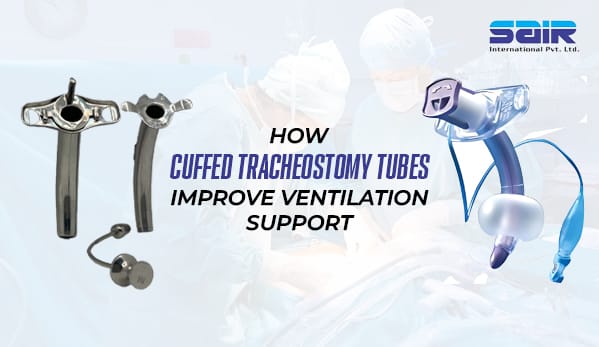In the realm of respiratory care, tracheostomy tubes serve as a vital intervention for patients requiring long-term airway management. Among the various types of tracheostomy tubes available, cuffed tracheostomy tubes stand out as a critical tool for optimizing ventilation support, enhancing patient safety, and improving overall outcomes. This blog delves into the mechanisms, benefits, and clinical applications of cuffed tracheostomy tubes, shedding light on their essential role in modern healthcare.
Understanding Cuffed Tracheostomy Tubes
A cuffed tracheostomy tube is a specialized device equipped with an inflatable balloon (the cuff) around its distal end. When inflated, this cuff creates a seal between the outer wall of the trachea and the tube, effectively isolating the lower airway from the upper airway. This design allows for controlled ventilation and reduces the risk of aspiration, making cuffed tubes particularly useful in critical care settings.
Cuffed tracheostomy tube come in various sizes and designs, tailored to meet the needs of diverse patient populations, from neonates to adults. These tubes can be made from materials such as polyvinyl chloride (PVC), silicone, or metal, each offering specific advantages depending on the clinical scenario.
Mechanisms of Ventilation Support
The primary function of cuffed tracheostomy tubes is to facilitate effective ventilation support. Here are some key mechanisms by which they achieve this:
- Sealing the Airway: The inflated cuff forms a secure seal within the trachea, ensuring that the ventilatory support delivered by a mechanical ventilator is directed entirely into the lungs. This prevents air from escaping through the upper airway, optimizing tidal volume and gas exchange.
- Preventing Aspiration: The cuff acts as a barrier, preventing secretions, gastric contents, or foreign materials from entering the lower respiratory tract. This is particularly crucial for patients with impaired swallowing reflexes or those at high risk of aspiration.
- Stabilizing Airway Pressure: By maintaining consistent airway pressure, cuffed tracheostomy tubes enable precise delivery of positive end-expiratory pressure (PEEP), which helps keep the alveoli open and improves oxygenation.
- Facilitating Mechanical Ventilation: For patients requiring invasive mechanical ventilation, cuffed tracheostomy tubes provide a reliable conduit for administering controlled breaths, monitoring airway pressures, and managing respiratory parameters.
Benefits of Cuffed Tracheostomy Tubes
The use of cuffed tracheostomy tubes offers several advantages, making them indispensable in various clinical scenarios:
- Enhanced Ventilation Efficiency: The airtight seal created by the cuff ensures that ventilatory support is effectively delivered to the lungs, improving oxygenation and carbon dioxide elimination.
- Reduced Risk of Aspiration: By preventing the entry of fluids or particles into the lower airway, cuffed tracheostomy tubes significantly lower the risk of aspiration pneumonia, a common and potentially life-threatening complication in critically ill patients.
- Improved Patient Safety: In emergency situations or during procedures, the cuffed tube’s ability to isolate the airway ensures that healthcare providers can maintain a secure airway and prevent complications such as hypoxia or airway obstruction.
- Versatility in Patient Care: Cuffed tracheostomy tubes are suitable for a wide range of clinical settings, including intensive care units (ICUs), long-term care facilities, and home healthcare. They can accommodate patients with varying levels of respiratory support needs.
- Facilitation of Speech and Swallowing: Modern cuffed tracheostomy tubes often include features like fenestrations or low-profile cuffs, which allow for partial deflation or the use of speaking valves, enabling patients to communicate and swallow more effectively.
Clinical Applications
Cuffed tracheostomy tubes are utilized across a variety of medical disciplines and conditions. Some common applications include:
- Critical Care: Patients in the ICU often require prolonged mechanical ventilation due to conditions such as acute respiratory distress syndrome (ARDS), sepsis, or traumatic injuries. Cuffed tracheostomy tubes provide the stability and control needed for optimal respiratory management.
- Neurological Conditions: Individuals with neurological disorders, such as stroke, traumatic brain injury, or amyotrophic lateral sclerosis (ALS), may experience impaired airway protection and require cuffed tracheostomy tubes to prevent aspiration and maintain adequate ventilation.
- Post-Surgical Care: After major surgeries involving the head, neck, or chest, cuffed tracheostomy tubes may be placed to ensure a secure airway and facilitate recovery.
- Management of Airway Obstructions: Conditions like tumors, severe infections, or congenital anomalies can cause upper airway obstruction, necessitating the use of cuffed tracheostomy tubes to bypass the blockage and maintain breathing.
- Palliative Care: In patients with terminal illnesses, cuffed tracheostomy tubes can be used to provide comfort and alleviate respiratory distress, ensuring dignity and quality of life.
Innovations in Cuffed Tracheostomy Tubes
Advancements in medical technology have led to significant improvements in the design and functionality of cuffed tracheostomy tubes. Some notable innovations include:
- Pressure-Regulating Cuffs: Modern tubes feature high-volume, low-pressure cuffs that minimize the risk of tracheal injury while maintaining an effective seal.
- Biofilm-Resistant Materials: The use of antimicrobial coatings or materials resistant to biofilm formation helps reduce the risk of infection and prolongs the lifespan of the tube.
- Adjustable Flanges: Customizable flanges allow for better fit and comfort, especially in pediatric or anatomically unique patients.
- Integrated Monitoring Systems: Some cuffed tracheostomy tubes now include integrated sensors to monitor cuff pressure, airway pressures, and even oxygen saturation, enhancing patient safety and clinical decision-making.
Challenges and Considerations
Despite their numerous benefits, the use of cuffed tracheostomy tubes requires careful management to avoid complications. Key considerations include:
- Cuff Pressure Management: Over inflation of the cuff can lead to tracheal damage, while underinflation may result in air leaks or aspiration. Regular monitoring and adjustment of cuff pressure are essential.
- Risk of Infection: Tracheostomy sites are prone to infection, necessitating meticulous care and hygiene practices to minimize the risk.
- Patient Comfort: Prolonged use of cuffed tracheostomy tubes can cause discomfort or mucosal irritation. Healthcare providers should prioritize patient comfort through proper tube selection, sizing, and care.
- Weaning Challenges: Transitioning patients from cuffed tracheostomy tubes to decannulation or alternative airway devices can be complex, requiring a multidisciplinary approach and thorough assessment.
Conclusion
Cuffed tracheostomy tubes play an indispensable role in modern respiratory care, offering unparalleled support for ventilation, airway protection, and patient safety. By creating an airtight seal within the trachea, these devices enable precise delivery of mechanical ventilation, reduce the risk of aspiration, and enhance overall clinical outcomes. As medical technology continues to evolve, innovations in cuffed tube design promise to further improve their efficacy, safety, and patient comfort.
For healthcare providers, understanding the principles, benefits, and challenges associated with cuffed tubes is crucial for delivering optimal care. By leveraging these devices effectively, clinicians can make a profound difference in the lives of patients with complex respiratory needs.


